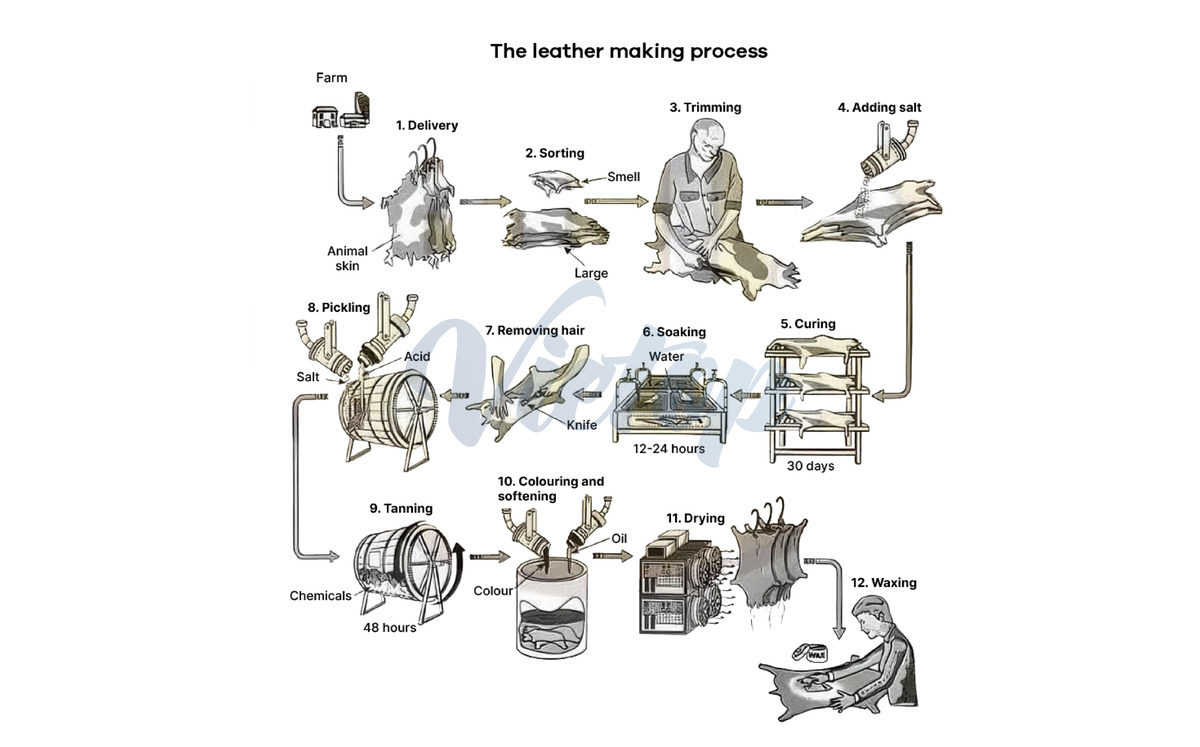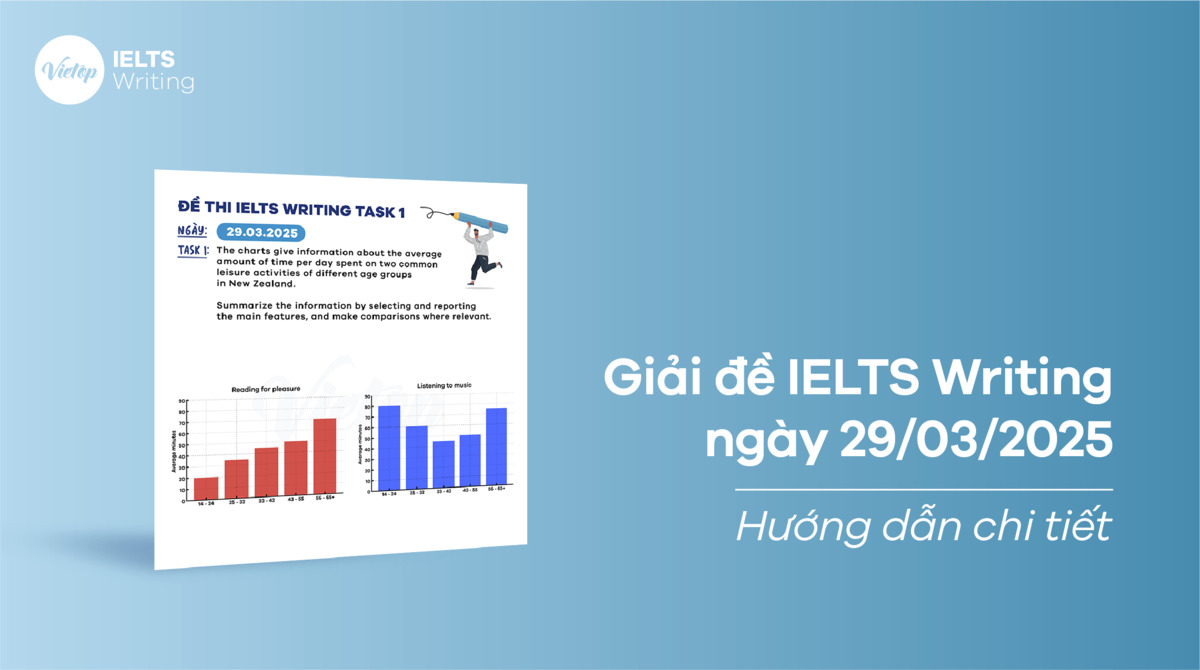Trong kỳ thi IELTS trên máy tính ngày 10/02/2025, đề thi Writing đã ra dạng bài Process ở Task 1. Dạng bài này theo đánh giá chủ quan của mình là khá khó và dài.
Cụ thể, đề bài như sau:
- Đề IELTS Writing Task 1: The diagram below shows the leather making process. Summarize the information by selecting and reporting the main features, and make comparisons where relevant.
Trong bài viết này, mình sẽ hướng dẫn bạn cách xử lý dạng bài này một cách hiệu quả – từ phân tích đề, lập dàn ý chi tiết đến áp dụng các chiến lược viết giúp bài viết mạch lạc, logic và thuyết phục hơn, giúp bạn tiến gần hơn đến band điểm mong muốn.
Cùng mình học bài thôi!
1. IELTS Writing Task 1
| The diagram below shows the leather making process. Summarize the information by selecting and reporting the main features, and make comparisons where relevant. |
| (Biểu đồ dưới đây mô tả quy trình sản xuất da. Hãy tóm tắt thông tin bằng cách chọn lọc và trình bày những đặc điểm chính, đồng thời thực hiện so sánh khi cần thiết.) |

1.1. Bước 1: Phân tích đề
- Dạng biểu đồ: Process
- Topic: Quá trình làm da thuộc
- Number of factors: N/A
- Time: N/A
- Tense: Các thì hiện tại
- Nhóm dữ liệu: chia làm 2 nhóm:
- Nhóm 1: Bước 1 tới 7 (không có chất hóa học)
- Nhóm 2: Bước 8 tới 12 (có chất hóa học)
- => có 2 đoạn thân bài
1.2. Bước 2: Lập dàn ý
Introduction: Paraphrase đề bài.
Overview:
- The process consists of twelve steps, beginning with preparation and preservation, followed by chemical treatments that refine the material into finished leather.
| Body paragraph 1 (Bước 1 tới 7- không sử dụng chất hóa học – giai đoạn chuẩn bị) | Body paragraph 2 (Bước 8 tới 12 – sử dụng chất hóa học – Xử lý & hoàn thiện) |
| – Bước 1: Animal skins are delivered from farms to a facility – Bước 2: The skins are sorted by size (small and large) – Bước 3: Workers trim away excess material – Bước 4: The hides are coated in salt to prevent decomposition – Bước 5: They are stacked on racks and left to cure for about a month – Bước 6: The hides are soaked in water (12-24 hrs) to rehydrate – Bước 7: Remaining hair is scraped off using a knife, leaving a smooth surface | – Bước 8: The skins are pickled (immersed in acid and salt to soften) – Bước 9: Tanning stage: chemicals are used for 48 hrs to strengthen the leather – Bước 10: The material is dyed, softened with oil, and prepared for the final stages – Bước 11: Industrial machines thoroughly dry the leather – Bước 12: A wax coating is applied to the leather |
Xem thêm cách viết các dạng bài khác:
- Cách viết IELTS Writing Task 1 từ A – Z cho người mới bắt đầu
- Cách viết Writing Task 1 dạng Table chi tiết
- Hướng dẫn cách viết dạng Maps IELTS Writing Task 1
1.3. Bước 3: Bài mẫu
1.3.1. Bài mẫu band 5.0+
The diagram shows the process of making leather, starting from collecting animal skins and finishing at the waxing stage. There are twelve steps in total, and they involve both chemical and physical processes to turn raw skins into leather.
To begin, the animal skins are delivered from the farms, and they are separated into different sizes. After this, the skins go through a trimming process where extra parts are cut off. Then, salt is added to the skins, which is important for stopping them from smelling bad. The hides are then put on a rack for curing, which lasts 30 days, before being placed in water for a soaking step that happens for up to 24 hours. When this is done, hair is removed with a knife.
After these steps, the skins are put in acid and salt, known as pickling, to make them soft. Next, the tanning process takes place in a rotating drum, where chemicals are used to make the leather stronger and prevent damage. This takes two days. Afterward, the leather is given colour and oils to make it soft before it is dried. In the last step, waxing is done to give a smooth and shiny surface.
1.3.2. Bài mẫu band 7.5+
The diagram illustrates the step-by-step process of leather production, from the initial preparation of raw animal hides to the final waxing stage.
Overall, the process consists of twelve distinct steps, beginning with the collection and treatment of the raw material, followed by chemical processing to refine the leather into a finished product.
In the first stage, animal skins are delivered from farms and subsequently sorted by size. Once categorized, the skins undergo manual trimming to remove excess material before being salted, a crucial step in preventing decomposition. The hides are then stacked on racks for curing, a process that takes approximately 30 days to fully preserve the material. Following this, they are soaked in water for 12 to 24 hours, which rehydrates the leather and prepares it for hair removal, a process typically carried out using a knife.
The subsequent stages involve chemical treatments and mechanical processing to transform the raw hide into usable leather. Initially, the skins undergo pickling, in which they are immersed in a solution containing acid and salt to soften the material. After that, they enter the tanning stage, where they are placed inside a large rotating drum filled with chemicals and left to soak for 48 hours. This process strengthens the leather, making it resistant to decay and wear. Once tanned, the material is coloured and softened using a combination of oils and dyes, after which it is mechanically dried. Finally, the processed leather undergoes a waxing procedure, ensuring a smooth and polished surface before the product is ready for use.
1.4. Từ vựng
| Từ vựng | Nghĩa |
| Animal hides | (noun phrase) da động vật E.g. Ancient tribes used animal hides for clothing and shelter. (Các bộ lạc cổ đại sử dụng da động vật để làm quần áo và nơi trú ẩn.) |
| Chemical processing | (noun phrase) quá trình xử lý hóa học (sử dụng hóa chất để biến đổi hoặc tinh chế một vật liệu gì đó) E.g. Some foods go through heavy chemical processing, which may affect their nutritional value. (Một số thực phẩm trải qua quá trình xử lý hóa học nặng, có thể ảnh hưởng đến giá trị dinh dưỡng của chúng.) |
| Refine | (verb) lọc, tinh chế, làm sách một chất E.g. The company uses advanced techniques to refine crude oil into gasoline. (Công ty sử dụng các kỹ thuật tiên tiến để tinh chế dầu thô thành xăng.) |
| Subsequently | (adverb) sau đó, kế tiếp, tiếp theo E.g. The company launched a new product and subsequently saw a rise in sales. (Công ty đã ra mắt một sản phẩm mới và sau đó chứng kiến doanh số tăng lên.) |
| Undergo | (verb) trải qua, chịu đựng E.g. The company will undergo a major restructuring to improve efficiency. (Công ty sẽ trải qua một cuộc tái cấu trúc lớn để nâng cao hiệu quả.) |
| Excess material | (noun phrase) vật liệu dư thừa E.g. The workers removed the excess material after cutting the metal sheets. (Công nhân đã loại bỏ vật liệu dư thừa sau khi cắt các tấm kim loại.) |
| Salted | (adjective) ướp muối E.g. In many cultures, salted fish is a traditional dish. (Trong nhiều nền văn hóa, cá ướp muối là một món ăn truyền thống.) |
| Decomposition | (noun) sự phân hủy E.g. The decomposition of leaves enriches the soil with nutrients. (Sự phân hủy của lá cây làm giàu dinh dưỡng cho đất.) |
| Curing | (noun) sự xử lý, quá trình làm khô, bảo quản, hoặc đông cứng vật liệu E.g. Traditional curing methods include smoking and drying fish. (Các phương pháp bảo quản truyền thống bao gồm xông khói và làm khô cá.) |
| Preserve | (verb) bảo quản E.g. Refrigeration helps preserve fresh vegetables and fruits. (Làm lạnh giúp bảo quản rau củ và trái cây tươi lâu hơn.) |
| Rehydrate | (verb) cấp nước lại, làm ẩm, khôi phục độ ẩm E.g. You need to rehydrate dried mushrooms before adding them to the dish. (Bạn cần ngâm nấm khô để phục hồi độ ẩm trước khi cho vào món ăn.) |
| Typically | (adverb) thường xuyên, điển hình E.g. A good student is typically well-organized and hardworking. (Một học sinh giỏi thường có tổ chức và chăm chỉ.) |
| Mechanical processing | (noun phrase) xử lý cơ học, gia công cơ khí E.g. The juice is extracted using mechanical processing rather than chemical methods. (Nước ép được chiết xuất bằng xử lý cơ học thay vì phương pháp hóa học.) |
| Pickling | (noun) muối chua, ngâm giấm, bảo quản thực phẩm bằng dung dịch muối hoặc giấm E.g. The process of pickling extends the shelf life of vegetables like cucumbers and onions. (Quá trình muối chua giúp kéo dài thời gian bảo quản các loại rau như dưa leo và hành.) |
| Immerse | (verb) nhúng, ngâm, dìm E.g. To soften the dried mushrooms, immerse them in warm water for 10 minutes. (Để làm mềm nấm khô, hãy ngâm chúng trong nước ấm khoảng 10 phút.) |
| Solution | (noun) dung dịch E.g. The scientist prepared a chemical solution for the experiment. (Nhà khoa học đã chuẩn bị một dung dịch hóa học cho thí nghiệm.) |
| Tanning | (noun) quá trình thuộc da E.g. Traditional tanning methods use plant-based chemicals to preserve animal hides. (Các phương pháp thuộc da truyền thống sử dụng hóa chất có nguồn gốc thực vật để bảo quản da động vật.) |
| Resistant | (adjective) chống lại, có khả năng chịu đựng, kháng cự E.g. This fabric is water-resistant, making it perfect for outdoor clothing. (Loại vải này chống nước, rất phù hợp cho trang phục ngoài trời.) |
| Decay | (noun) sự suy tàn, phân rã, hư hỏng E.g. Organic matter undergoes decay when exposed to moisture and bacteria. (Chất hữu cơ trải qua quá trình phân hủy khi tiếp xúc với độ ẩm và vi khuẩn.) |
| Wear | (noun) sự hao mòn E.g. The shoes show signs of wear after months of daily use. (Đôi giày có dấu hiệu hao mòn sau nhiều tháng sử dụng hàng ngày.) |
| Waxing procedure | (noun phrase) quy trình phủ sáp lên bề mặt E.g. The car’s waxing procedure helps protect the paint and give it a glossy finish. (Quy trình phủ sáp cho xe giúp bảo vệ lớp sơn và tạo độ bóng.) |
1.5. Cấu trúc
1.5.1. Câu phức với cụm đồng vị ngữ
| S + V + O, N + that + V’ + O’ |
E.g. The hides are then stacked on racks for curing, a process that takes approximately 30 days to fully preserve the material.
(Sau đó, các tấm da được xếp lên giá để thực hiện quá trình thuộc da, một quy trình mất khoảng 30 ngày để bảo quản hoàn toàn vật liệu.)
- Mệnh đề chính: “The hides are then stacked on racks for curing”
=> Mệnh đề chính sử dụng câu bị động nhằm nhấn mạnh hành động xếp các tấm da lên giá, thay vì tập trung vào chủ thể thực hiện hành động.
- Cụm đồng vị ngữ: “a process that takes approximately 30 days to fully preserve the material”
- Mệnh đề quan hệ trong cụm đồng vị ngữ: “that takes approximately 30 days to fully preserve the material.
=> Cụm đồng vị ngữ đóng vai trò bổ sung thông tin cho mệnh đề chính (đưa ra thông tin thêm cho quá trình curing). Mệnh đề quan hệ cũng đóng vai trò bổ sung thông tin cho danh từ “process”, giải thích thêm về độ dài của quá trình.
1.5.2. Mệnh đề quan hệ
| S + V + O + which + V’ + O’ |
E.g. They are soaked in water for 12 to 24 hours, which rehydrates the leather and prepares it for hair removal.
(Chúng được ngâm trong nước từ 12 đến 24 giờ, giúp da phục hồi độ ẩm và chuẩn bị cho quá trình loại bỏ lông.)
- Mệnh đề chính: “They are soaked in water for 12 to 24 hours”
=> Mệnh đề chính sử dụng câu bị động nhằm mục đích nhấn mạnh hành động ngâm nước từ 12 tới 24 tiếng, thay vì tập trung vào chủ thể thực hiện hành động.
- Mệnh đề quan hệ: “which rehydrates the leather and prepares it for hair removal.”
=> Mệnh đề quan hệ giúp bổ sung thông tin cho hành động “soaked in water for 12 to 24 hours”, giải thích cho kết quả của việc ngâm da vô nước trong 12 tới 24 tiếng.
Xem thêm các bài giải khác:
- [ACE THE TEST] Giải đề IELTS Writing ngày 08/02/2025
- [ACE THE TEST] Giải đề IELTS Writing Task 2 ngày 25/01/2025
- [ACE THE TEST] Giải đề IELTS Writing ngày 18/01/2025
- Tổng hợp đề thi IELTS Writing 2025 kèm bài mẫu chi tiết – Cập nhật liên tục
2. Kết luận
Việc ôn luyện kỹ lưỡng cho IELTS Writing không chỉ giúp bạn tự tin hơn khi bước vào kỳ thi mà còn nâng cao khả năng đạt band điểm như mong muốn. Hy vọng rằng qua bài giải đề IELTS Writing Task 1 ngày 10/02/2025, bạn đã nắm vững những chiến lược quan trọng để cải thiện kỹ năng viết và áp dụng hiệu quả vào bài thi thực tế.
Nếu bạn có bất kỳ thắc mắc nào hoặc cần sự hỗ trợ, hãy để lại bình luận bên dưới nhé! Đội ngũ Vietop English luôn sẵn sàng đồng hành, lắng nghe và hỗ trợ bạn tận tình trên hành trình chinh phục IELTS.
Chúc các bạn ôn tập tốt và đạt được kết quả cao trong kỳ thi IELTS sắp tới!


![[ACE THE TEST] Giải đề IELTS Writing ngày 07/04/2025](https://vietop.edu.vn/wp-content/uploads/2025/04/giai-de-ielts-writing-ngay-07-04-2025.png)

![[ACE THE TEST] Giải đề IELTS Writing ngày 15/03/2025](https://vietop.edu.vn/wp-content/uploads/2025/03/giai-de-ielts-writing-ngay-15-03-2025.jpg)
![[ACE THE TEST] Giải đề IELTS Writing ngày 22/03/2025](https://vietop.edu.vn/wp-content/uploads/2025/03/giai-de-ielts-writing-ngay-22-03-2025.jpg)
![[ACE THE TEST] Giải đề IELTS Writing ngày 08/03/2025](https://vietop.edu.vn/wp-content/uploads/2025/03/giai-de-ielts-writing-ngay-08-03-2025.jpg)
![[ACE THE TEST] Giải đề IELTS Writing ngày 06/03/2025](https://vietop.edu.vn/wp-content/uploads/2025/03/giai-de-ielts-writing-ngay-06-03-2025.jpg)
![[ACE THE TEST] Giải đề IELTS Writing ngày 22/02/2025](https://vietop.edu.vn/wp-content/uploads/2025/02/giai-de-ielts-writing-ngay-22-02-2025.jpg)
